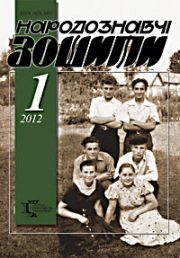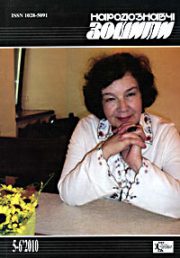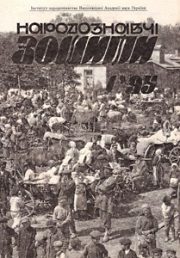The Ethnology Notebooks. 2022. № 4 (166), 814—826
UDK: 393.1(477.85/.87)
DOI https://doi.org/10.15407/nz2022.04.814
FROM THE FUNERAL AND MEMORIAL RITE OF HUTSUL RЕGION
HALAICHUK Volodymyr
- ORCID ID: https://orcid.org/0000-0001-7780-5876
- Doctor of Sciences in the field of History,
- Professor of the Department of Ethnology,
- Ivan Franko National University of Lviv
- 1, Universytetska Str., 79000, Lviv, Ukraine
- Contacts: e-mail: halay_czuk@ukr.net
Abstract. Formulation of the problem. The study of funeral and memorial motifs provides the key to understanding many phenomena of the traditional culture of Ukrainians. Therefore, the need to publish new ethnographic materials is still relevant.
The degree of research of the topic and the source base of the research. Funeral and memorial customs and rites of the Hutsuls are well known to researchers. At one time, they were the object of interest of such famous ethnographers as Raimund Kaindl, Volodymyr Shukhevych, Anton Onyschuk, Petro Shekeryk-Donykiv, Zenon Kuzelya, Filaret Kolessa. Modern ethnologists, folklorists, and linguists continue to work on the specified topic — Roman Huziy, Mykhailo Zelenchuk, Valentyna Sushko, Iryna Koval-Fuchylo, Olha Pyskach, and others. The basis for this publication was the author’s field materials recorded from respondents from the Verkhovyna and Kosiv districts of the Ivano-Frankivsk region.
The purpose of the study is to introduce into scientific circulation, systematize and partly analyze a mass of new information about traditional funeral and memorial customs and rites of the Hutsul region, including the calendar component.
The omens that seem to foretell death are considered; features of the agony of people who are «acquainted with evil spirits»; funeral preparations; apotropaic from the deceased; «sitting» next to the dead, in particular the tradition of games with the deceased; burial customs; actions with certain funeral attributes; commemoration of the deceased immediately after the funeral; arrangement of the grave; features of mourning.
Customs and superstitions related to the burial of children, including unbaptized children, suicides, witches and ghouls, became micro-themes of the research.
A separate block of research concerns commemorative motifs in customs and rites of the annual cycle. Considered the commemoration of the souls of the departed on «soul days» and on Christmas Eve; baking memorial «knуshі» during Great Lent; dedicated to Maundy Thursday the customs of «khodyty u vohnyky» and «hrity dida»; the custom of honoring «rakchmans»; commemorative customs of Easter and the Savior.
Keywords: Hutsul region, funeral and memorial customs and rites, beliefs, spiritual culture, the deceased, «vohnyky», «rakhmany».
Received 11.07.2022
RЕFЕRЕNCЕS
- Kaindl, R. (2000). Hutsuls: their life, customs and folk tales. Chernivtsi: Molodyі Bukovynets [in Ukrainian].
- Shukhevych, V. (1902). Hutsul land (Part 3). Lviv [in Ukrainian].
- Hnatiuk, V. (1912). Funeral customs and rites. Etnografichnyj zbirnyk (Vol. ХХХІ—ХХХІІ, pp. 131—424). Lviv [in Ukrainian].
- Kuzelia, Z. (1914). Sitting and entertainment at the dead in the Ukrainian funeral rite. Zapysky Naukovoho tovarystva imeni Shevchenka (Vol. СХХІ, pp. 173—224). Lviv [in Ukrainian].
- Kuzelia, Z. (1915). Sitting and fun at the dead in the Ukrainian funeral rite (Thе еnd). Zapysky Naukovoho tovarystva imeni Shevchenka (Vol. СХХІІ, pp. 103—166). Lviv [in Ukrainian].
- Kolessa, F. (2001). Beliefs about the soul and the afterlife in Ukrainian funeral and memorial rituals. Zapysky Naukovoho tovarystva imeni Shevchenka (Vol. ССХLII : Proceedings of the Section of Ethnography and Folkloristics, pp. 7—82). Lviv [in Ukrainian].
- Huzij, R. (2007). From folk thanatology: Carpathian studies. Lviv: Institute of Ethnology of the National Academy of Sciences of Ukraine [in Ukrainian].
- Zelenchuk, M. (2003). Funeral customs and rites in the Hutsul region: games and fun at the deceased. Dialectological studies (Issue 2 : Language and culture, pp. 241—247). Lviv [in Ukrainian].
- Sushko, V. (2014). Perceptions of death and funeral customs of the Hutsuls. Narodna tvorchist ta etnolohiia, 1, 91—97 [in Ukrainian].
- Koval-Fuchylo, I. (2012). Character code of the funeral rite in Kosiv region: Trembitar. Narodna tvorchist ta etnolohiia, 4, 89—93 [in Ukrainian].
- Pyskach, O. (2016). Names related to funeral and memorial rites in dialect dictionaries of the southwestern dialect of the Ukrainian language. Suchasni problemy movoznavstva ta literaturoznavstva : coll. of science works (Issue 21 : Areology and onomastics, pp. 124—130). Uzhhorod [in Ukrainian].
- Skrypnyk, H. (Chairman ed.). (2020). Ethnographic image of modern Ukraine. Corpus of expeditionary folklore and ethnographic materials (Vol. 5 : Funeral and memorial customs and rites). Kyiv [in Ukrainian].
- Archive of Ivan Franko Lviv National University, f. 119, op. 17, od. save 317-E [in Ukrainian].
- Archive of Ivan Franko Lviv National University, f. 119, op. 17, od. save 715-E [in Ukrainian].
- Archive of Ivan Franko Lviv National University, f. 119, op. 17, od. save 719-E [in Ukrainian].
- Denysiuk, I. (2003). Hadyerka. Visnyk of the Lviv University. Philological series (Issue31, pp. 422—428). Lviv: Ivan Franko National University of Lviv [in Ukrainian].
- Struk, M. Vohnyky, kukutsi, khapanky, zhyvnyky. The ancient Hutsul tradition has been preserved in Kosiv region. Retrieved from: https://www.youtube.com/watch?v=l5dfaHCr44w (Last accessed: 03.06.2022).







